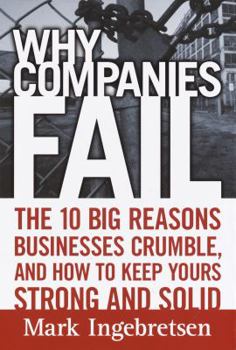Why Companies Fail: The 10 Big Reasons Businesses Crumble, and How to Keep Yours Strong and Solid
At the height of the global bull market a few years ago, business giant Kmart stumbled, going from one of the most admired companies to one of the largest bankruptcies in history. The same fate befell... This description may be from another edition of this product.
Format:Hardcover
Language:English
ISBN:0761563741
ISBN13:9780761563747
Release Date:May 2003
Publisher:Crown Publishing Group (NY)
Length:292 Pages
Weight:1.40 lbs.
Dimensions:1.0" x 6.4" x 9.3"
Customer Reviews
2 ratings
The Causes of Self-Inflicted Doom
Published by Thriftbooks.com User , 20 years ago
Consider these statistics: In 2001, 257 public companies (with a total of $258 billion in assets) declared bankruptcy. In 2002, another 67 did so. Go back even further to the 43 companies which Peters and Waterman quite properly praised in In Search of Excellence (1982). Most no longer qualify according to the criteria by which they were selected...and several do not exist at all. Scary? You bet. Most of us in business can probably draw up a list of at least 15-20 reasons why companies fail. In this book, Ingebretsen focuses on what he calls "The Ten Deadly Sins." Committing any one of these "sins" could easily put a company at serious risk, if not completely out of business. Ignoring Customers (e.g. IBM), for example, or Failed Synergies (e.g. AOL and Time Warner). In fact, most organizations -- non-profit as well as for-profit, regardless of size or nature -- commit one or more of these "deadly sins" each day. Some violations are the equivalent of a felony, others of a misdemeanor. Presumably Ingebretsen agrees with me that individual mistakes can be damaging but not necessarily fatal; what all organizations must avoid are certain patterns of behavior which ensure failure. I recall a conversation I had years ago with the owner/CEO of a small company which had just filed for Chapter 7 bankruptcy. The situation was hopeless. "All of the problems developed slowly and then suddenly." Ingebretsen carefully organizes his material within 14 chapters which are arranged in a specific sequence, beginning with The Deadly Spiral and concluding with Future Challenges. The value of each chapter will be determined, of course, by the nature and extent of each reader's immediate needs and interest. However, Ingebretsen offers an eloquent and compelling explanation of why each of "The Ten Deadly Sins" is so dangerous after identifying (in Chapters 2 and 3) Early Warning Signs" and "More Early Warning Signs." Unlike vehicles, companies do not have gauges arranged conveniently in a cluster which immediately indicate when they are going too fast, overheating, running out of fuel, etc. In The Inferno, Dante saved the last ring in hell for those who, in a moral crisis, preserve their neutrality. I thought about that as I read Chapter 13 in which Ingebretsen "saves the worst corporate sin for last": arrogance. (For example, Enron, Polaroid, and Webvan.) In the final chapter, he shifts his attention to "probable causes for business failures in the years ahead, when all companies must run on Internet time."For me, some of Ingebretsen's best thinking is provided in the Appendix: In Search of a Failure-Proof Strategy. However, the value of the Appendix to a great extent depends on how carefully the previous 14 chapters have been read. It is also important to keep in mind that competing on Internet time involves change which now occurs with unprecedented velocity as well as frequency. According to Ingebretsen, "the one constant, sadly, is that companies that either can't
Insightful Presentation
Published by Thriftbooks.com User , 20 years ago
Reads like a "whodunit" of business failures. Ingebretsen offers his readers a polished presentation. His writing style is highly accessible. This is refreshing given the number of writers in management theory who choose to hide behind jargon laden academic descriptions, as opposed to clearly stating the evidence behind a company's success or demise. As someone interested in organizational analysis and who has the intention of starting up a business some day, I highly recommend this book. It is a quick and enjoyable read offering the means to avoid the pit falls of management failure.




